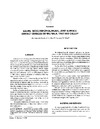Please use this identifier to cite or link to this item:
https://accedacris.ulpgc.es/handle/10553/106667
| Title: | Equine metacarpophalangeal joint surface contact changes during walk, trot and gallop | Authors: | Vilar Guereño, José Manuel Pinedo, M. De Mier, J. Castejon, F. Riber, C. |
UNESCO Clasification: | 310907 Patología | Issue Date: | 1995 | Journal: | Journal of Equine Veterinary Science | Abstract: | Changes in the staining pattern for the metacarpophalangealjoint in the walking, trotting and galloping positions were studied. For this purpose, horse limbs from the third metacarpal bone distally were harvested and placed in the mid-stance position on a hydraulic press that applied the load required to obtain the palmar fetlock angles corresponding to the walking (218 degrees), trotting (226 degrees) and galloping positions (240 degrees), and a 1:1000 diluted aqueous dilution of methylene blue was injected into the fetlock joint. Based on the results, increasing the palmar fetlockangle in the anatomical specimen caused the contact zones of the proximal phalanx and the proximal sesamoidean bones with the third metacarpal bone joint surface to shift dorsally, thereby increasing the contact surface area between the involved bones. In the galloping position, the proximal phalanx wasfound to extend beyond the dorsal boundary of the third metacarpal bone joint surface and its basal portion to depart from the metacarpus in such a way that the distal sesamoidean ligaments forced the basilar zone of the proximal sesamoidean bones to separate. These phenomena may obviously assist in explaining the intricate biomechanics of the joint as well as its associated pathologies. | URI: | https://accedacris.ulpgc.es/handle/10553/106667 | ISSN: | 0737-0806 | DOI: | 10.1016/S0737-0806(06)81737-5 | Source: | Journal of Equine Veterinary Science [ISSN 0737-0806], v. 15(7), p. 315-319 |
| Appears in Collections: | Artículos |
WEB OF SCIENCETM
Citations
6
checked on Jun 8, 2025
Page view(s)
67
checked on May 4, 2024
Download(s)
211
checked on May 4, 2024
Google ScholarTM
Check
Altmetric
Share
Export metadata
Items in accedaCRIS are protected by copyright, with all rights reserved, unless otherwise indicated.
